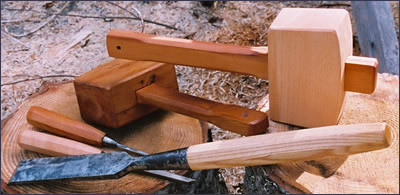Course 6–
|
Simple Tool Making
In Wood and Metal
|

Course Schedules
Course Description
This course is suitable for students with experience in Course
1 or Course 2.
The aim of the course is to help students acquire tools that are
normally difficult to find in typical retail outlets. View
some examples.
As well as making tools from basic materials (like brass, high
carbon steel and hardwoods) students will be encouraged to find
discarded or second hand tools that might be restored to something
that functions better than ever before.
In this course students may choose to make several tools from
the list that follows:
- Hardwood Mallet – The mallet
may be made in various sizes. There are two pieces; a head and
a handle. The choice
of material is very important. We like to use yew, hickory, cherry,
maple or beech but any close grained hardwood will suit.
- Marking or Cutting
Gauge – This
gauge is made from a dense hardwood. It has a metal screw for
adjustment and a
tool steel spur.
- Marking Knife or Layout
Knife - Such a knife is very difficult
to find, so we make our own from saw steel. A thin bladed knife
is best for layout work. We use a pattern for the shape of
the blade and it is ground and filed to shape. The blade is then
hardened
and tempered. Two hardwood cheeks are riveted in place to form
a handle. Finally the knife is honed to a keen edge.
- Bench Stop – This may be made
from steel or brass or dense hardwood. It is modeled after the
bench stop used
here at the school.
Precise measurement is required to make the bench stop. For
the metal stops, careful soldering completes the fabrication.
The wooden
ones are glued together.
- Dovetail Template – This is made from solid brass
which must be annealed before bending. The slope on the dovetail
is made
to suit the type of wood selected for the work. Most tool boxes
contain at least 3 or 4 templates with different slopes.
- Bench Hook – A properly made bench hook is indispensable
at the work bench. Any good, stable hardwood will suffice.
It is best made without metal fastenings.
- Vise Cheeks – All cast iron vises are likely to damage
woodwork and tools if the castings are not covered properly
with wooden protectors known as vise cheeks. Cheeks are made
from close
grained hardwood. This should not be seen as wasteful or extravagant.
A pair of vise cheeks in regular use will last 30 years or
more. We have patterns available for all Record vises. Vises
from other
manufacturers can be similarly guarded.
- Depth Gauge - This is easy to make from a block of hardwood
and a length of dowel. This useful tool ought to be made in
a variety of sizes. It is useful for finding the depth of a mortise
or a
carved recess etc.
- Chisel Handle – Sometimes at a flea market or a garage
sale one might come across a chisel with no handle. Sometimes
such a tool will be of superior quality and a new handle will
restore
its usefulness. We make handles from woods like yew, ash, arbutus
and hickory. The handle has an octagonal section tapered and
chamfered to suit the chisel. This kind of handle works very
well.
- Cabinet Scraper – Although
rectangular scrapers are readily available, we find at the school
that scrapers with
curved edges are equally important. We make scrapers from the
saw steel
salvaged from discarded hand saws. The scrapers we make range
in size from very small (finger and thumb type scrapers) to the
more
common large sizes. Often the shape of the scraper is ground
and filed to suit the contour of the work in hand.
Course Content
- Measurement and lay out
- Use of the bench and vise
- Safey in the workshop
- Sharpening edge tools
- Choice of suitable tools
- Choice of suitable hardwoods and their sources
- Use of the band saw
- Use of the table saw
- Use of the drill press
- Use of files and precision filing
- Use of the grinder – wet and dry
- Hardening and tempering of steel
- Annealing and normalizing metal
- Cleaning and pickling non-ferrous metal
- Hand polishing
- Machine polishing
- Soldering
- Riveting
- Thread cutting
The cost of all materials (wood, metal, glue, abrasive paper,
finish coatings, hardware
and fastenings etc.) is the responsibility
of the student.
|
